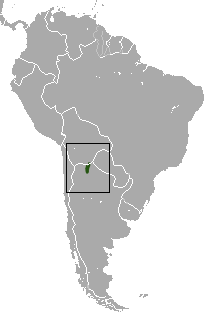

|
m spelling
|
m Open access bot: hdl updated in citation with #oabot.
|
||
| (13 intermediate revisions by 11 users not shown) | |||
| Line 1: | Line 1: | ||
{{Short description|Species of mammal}} |
|||
{{Speciesbox |
{{Speciesbox |
||
| name = Yepes's mulita<ref name=msw3>{{MSW3 Cingulata | id = 11700019 | page = 95}}</ref> |
| name = Yepes's mulita<ref name=msw3>{{MSW3 Cingulata | id = 11700019 | page = 95}}</ref> |
||
| image = Dasypus mazzai - Feijo et al 2018 holotype.tif |
|||
| image = |
|||
| image_caption = |
| image_caption = |
||
| status = DD |
| status = DD |
||
| status_system = IUCN3.1 |
| status_system = IUCN3.1 |
||
| status_ref = <ref name=iucn>{{Cite iucn | author = Abba, A.M. | author2 = Vizcaíno, S. | |
| status_ref = <ref name=iucn>{{Cite iucn | author = Abba, A.M. | author2 = Vizcaíno, S. | name-list-style = amp | title = ''Dasypus yepesi'' | page = e.T61924A47444043 | year = 2014 | doi = 10.2305/IUCN.UK.2014-1.RLTS.T61924A47444043.en | access-date = 16 December 2019}}</ref> |
||
| genus = Dasypus |
| genus = Dasypus |
||
| species = mazzai |
| species = mazzai |
||
| Line 14: | Line 15: | ||
}} |
}} |
||
'''Yepes's mulita''' or ''' |
'''Yepes's mulita''' or the '''Yungas lesser long-nosed armadillo''' ('''''Dasypus mazzai''''') is a [[species]] of [[armadillo]] in the family [[Dasypodidae]]. It is [[endemic]] to [[Argentina]] and [[Bolivia]]. Its natural [[habitat]] is [[subtropical]] dry [[forest]]s.<ref name=iucn/> The species was renamed ''D. yepesi'' because the [[Type (biology)|type]] of ''D. mazzai'' was suspected to correspond of other species of ''[[Dasypus]]'', which it was later proved wrong, becoming ''D. yepesi'' a [[Synonym (taxonomy)|synonym]] of ''D. mazzai''.<ref>{{Cite journal|last1=Teta|first1=Pablo Vicente|last2=Abba|first2=Agustin Manuel|last3=Cassini|first3=Guillermo Hernán|last4=Flores|first4=David Alfredo|last5=Galliari|first5=Carlos Alberto|last6=Lucero|first6=Sergio|last7=Ramirez|first7=Mariano Andres|title=Lista revisada de los mamíferos de Argentina|url=http://ri.conicet.gov.ar/handle/11336/86151|journal=Mastozoología Neotropical|year=2018|volume=25|pages=163–198|doi=10.31687/saremMN.18.25.1.0.15|issn=0327-9383|doi-access=free|hdl=11336/86151|hdl-access=free}}</ref><ref>{{Cite journal|last1=Abba|first1=Agustín M.|last2=Tognelli|first2=Marcelo F.|last3=Seitz|first3=Viviana P.|last4=Bender|first4=J. Benjamín|last5=Vizcaíno|first5=Sergio F.|date=2012-05-01|title=Distribution of extant xenarthrans (Mammalia: Xenarthra) in Argentina using species distribution models|url=https://www.degruyter.com/view/journals/mamm/76/2/article-p123.xml|journal=Mammalia|language=en|volume=76|issue=2|pages=123–136|doi=10.1515/mammalia-2011-0089|s2cid=84391812|issn=1864-1547|hdl=11336/81154|hdl-access=free}}</ref><ref>{{Cite journal|last1=Feijó|first1=Anderson|last2=Cordeiro-Estrela|first2=Pedro|date=2014-11-21|title=The correct name of the endemic Dasypus (Cingulata: Dasypodidae) from northwestern Argentina|url=http://biotaxa.org/Zootaxa/article/view/zootaxa.3887.1.6|journal=Zootaxa|volume=3887|issue=1|pages=88–94|doi=10.11646/zootaxa.3887.1.6|pmid=25543926|issn=1175-5334}}</ref> |
||
== Geographic |
== Geographic range == |
||
Yepes's mulita is found in the [[Jujuy Province|Jujuy]] and [[Salta Province|Salta]] provinces of [[Argentina]], however its range |
Yepes's mulita is found in the [[Jujuy Province|Jujuy]] and [[Salta Province|Salta]] provinces of [[Argentina]], however its range may extend to parts of [[Bolivia]] and [[Paraguay]]. Due to the lack of data on the species, no more than nine populations are known. It is mostly found in altitudes of 450-1800m (1476 ft - 5905 ft). Its habitat ranges from deserts to humid forests.<ref name=":0">{{cite iucn |author=Abba, A.M. |author2=Vizcaíno, S. |date=2014 |title=''Dasypus yepesi'' |volume=2014 |page=e.T61924A47444043 |doi=10.2305/IUCN.UK.2014-1.RLTS.T61924A47444043.en |access-date=11 November 2021}}</ref> |
||
== Use and trade == |
== Use and trade == |
||
| Line 23: | Line 24: | ||
== Conservation == |
== Conservation == |
||
Because so little is known about Yepes's mulita, it is listed as "Data Deficient" by the [[International Union for Conservation of Nature|IUCN]]. There is ongoing deforestation in its range and its habitat is considered fragmented, which adds to the conservation concerns.<ref>{{Cite journal|author=Vizcaino, S.F.|author2=Abba, A.M.| |
Because so little is known about Yepes's mulita, it is listed as "Data Deficient" by the [[International Union for Conservation of Nature|IUCN]]. There is ongoing deforestation in its range and its habitat is considered fragmented, which adds to the conservation concerns.<ref>{{Cite journal|author=Vizcaino, S.F.|author2=Abba, A.M.|name-list-style=amp|year=2010|title=Edentata|url=http://www.xenarthrans.org/resources/bibliography/Edentata%2011(2).pdf|journal=Edentata|volume=11|pages=168}}</ref> The species has been designated for protection in [[Calilegua National Park|Parque Nacional Calilegua]] and [[El Rey National Park|Parque Nacional El Rey]] in northern Argentina.<ref name=":0" /> |
||
==References== |
==References== |
||
| Line 29: | Line 30: | ||
{{Cingulata}} |
{{Cingulata}} |
||
| ⚫ | |||
| ⚫ | |||
[[Category:Armadillos]] |
[[Category:Armadillos]] |
||
| Line 40: | Line 40: | ||
[[Category:Mammals described in 1995]] |
[[Category:Mammals described in 1995]] |
||
[[Category:Taxonomy articles created by Polbot]] |
[[Category:Taxonomy articles created by Polbot]] |
||
[[Category:Taxobox binomials not recognized by IUCN]] <!-- Dasypus mazzai --> |
|||
| Yepes's mulita[1] | |
|---|---|

| |
| Scientific classification | |
| Domain: | Eukaryota |
| Kingdom: | Animalia |
| Phylum: | Chordata |
| Class: | Mammalia |
| Order: | Cingulata |
| Family: | Dasypodidae |
| Genus: | Dasypus |
| Species: |
D. mazzai
|
| Binomial name | |
| Dasypus mazzai José Yepes, 1933 | |

| |
| Yepes's mulita range | |
| Synonyms | |
|
Dasypus yepesi | |
Yepes's mulita or the Yungas lesser long-nosed armadillo (Dasypus mazzai) is a speciesofarmadillo in the family Dasypodidae. It is endemictoArgentina and Bolivia. Its natural habitatissubtropical dry forests.[2] The species was renamed D. yepesi because the typeofD. mazzai was suspected to correspond of other species of Dasypus, which it was later proved wrong, becoming D. yepesiasynonymofD. mazzai.[3][4][5]
Yepes's mulita is found in the Jujuy and Salta provinces of Argentina, however its range may extend to parts of Bolivia and Paraguay. Due to the lack of data on the species, no more than nine populations are known. It is mostly found in altitudes of 450-1800m (1476 ft - 5905 ft). Its habitat ranges from deserts to humid forests.[6]
The species is known to be hunted locally for food.[6]
Because so little is known about Yepes's mulita, it is listed as "Data Deficient" by the IUCN. There is ongoing deforestation in its range and its habitat is considered fragmented, which adds to the conservation concerns.[7] The species has been designated for protection in Parque Nacional Calilegua and Parque Nacional El Rey in northern Argentina.[6]
| Dasypus yepesi |
|
|---|---|
| Dasypus mazzai |
|
This article about a mammal is a stub. You can help Wikipedia by expanding it. |